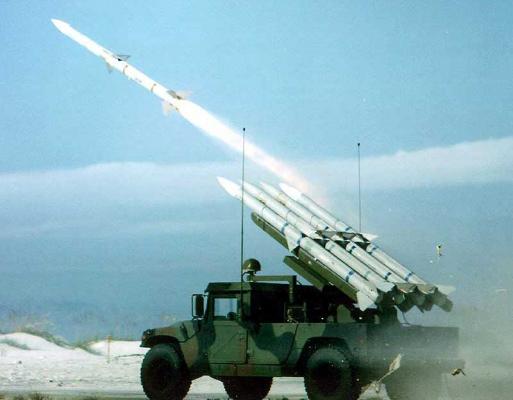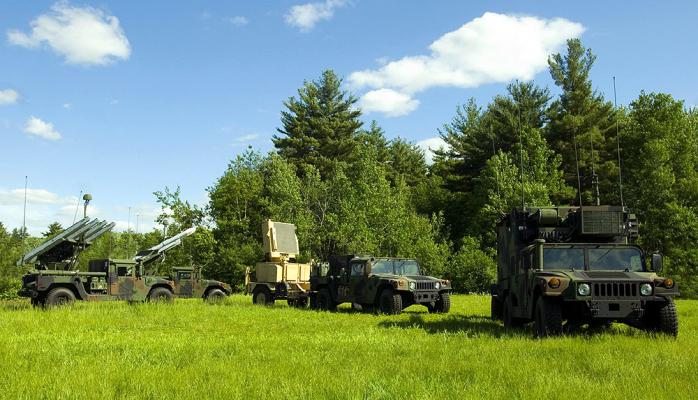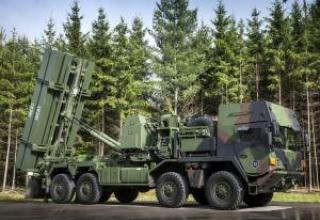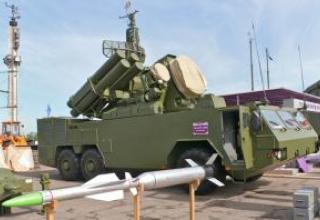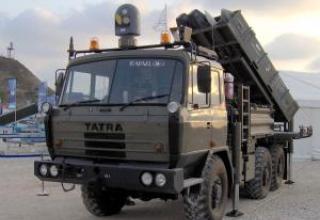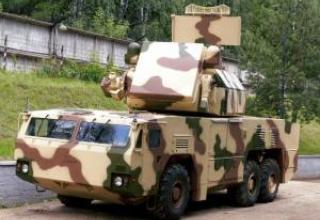SLAMRAAM mobile anti-aircraft missile system (SAM) is designed for air defense of troops and infrastructure against attacks of various types of air attack means day and night in all weather conditions, including the active use of enemy electronic countermeasures. It is designed to engage aerodynamic targets (including unmanned aerial vehicles and cruise missiles) at ranges of up to 25 km at extremely low and low altitudes.
The concept of an anti-aircraft missile system using the AIM-120A aircraft missile as a means of destruction was proposed by the American firm Hughes Aircraft in the early 90's in the development of a promising SAM system under the AdSAMS (Advanced Surface-to-Air Missile System) program. In 1992, the AdSAMS system came out for testing, but later this project was not developed. In March 1994, the firm "Hughes Aircraft" (now "Raytheon Company System") signed a contract for the development of NASAMS (Norwegian Advanced Surface to Air Missile System), the architecture of which in many ways repeated the project AdSAMS. Development of complex NASAMS together with the company Norsk Forsvarteknologia (now "Kongsberg Defence") was successfully completed in a short time and in 1995 began its production. Currently, NASAMS SAM system is in service with the Norwegian and Spanish Armed Forces.
The development of a similar complex for the U.S. Army was conducted under the HUMRAAM program (Project 559). In order to improve the combat capabilities and mobility of the complex, the launchers and fire control systems have been modified, first of all. The combat vehicles of the complex were placed on light all-terrain vehicle chassis. The first launches of the AIM-120A missile as part of the HUMRAAM SAM system were made in August 1997, and the first firing on a simulator cruise missile was held in July 1998.
In the early 90s, work also began on the development of CLAWS (Complementary Low Altitude Weapon System) SAM systems using an AIM-120 missile for the U.S. Marine Corps. During the tests, the experimental models of the complex successfully intercepted targets at ranges up to 15 km. In April 2001, the U.S. Marine Corps Command signed a contract with Raytheon to develop CLAWS SAM systems. Tests conducted in 2003-2004 at the White Sands Range (New Mexico) confirmed the combat capabilities of the new complex under various conditions, including nighttime, on different targets. In 2005, a series of firing on a low-flying cruise missile simulator was successfully completed. In 2005 Raytheon was awarded an additional contract under the CLAWS program, however, in August 2006 the customer decided to stop the development and production of this complex due to reduced funding.
In February 2004 the US Department of Defense signed a contract with Raytheon for the full-scale development of the SLAMRAAM (Surface Launched Advanced Medium Range Air-to-Air Missile) based on the AIM-120 missile for the US Army. In November 2005 the tests of SLAMRAAM launch vehicle samples were carried out, and in October 2006 it was declared about the completion of works on modernization of AIM-120 missile for use in SLAMRAAM SAM systems. The modernized missile is equipped with a new self-destruct system, revised software and has increased efficiency against cruise missiles and UAV. The tests of the complex started in March 2008. In July 2008, a series of tests on the interaction of SLAMRAAM air defense systems with the anti-aircraft systems "Avenger" and "Patriot". On June 2, 2009, on the White Sands test site, AIM-120C7 SLAMRAAM SAM systems successfully intercepted a low-flying maneuvering UAV at the maximum range. The target designation was provided by three separated AN/MPQ-64 radars from the network of SLAMRAAM SAM systems, and the group was controlled from a single fire control point. The purpose of the tests, organized by Raytheon and the U.S. Army Command, was to demonstrate the prospects of using SLAMRAAM as part of a single air defense system, which combines various means of detection and protection against air attack.
The first SLAMRAAM SAM system battery is scheduled for delivery to the U.S. Army in 2012. It is expected that in the future this system will replace the Avenger short-range air defense systems.
In 2007, the Raytheon company announced the start of work on a new antiaircraft missile SLAMRAAM-ER with a range up to 40 km. Along with SLAMRAAM-ER in the new promising complex, the developers plan to use the AIM-9X aircraft missile as a means to destroy the short-range (up to 10 km).
Composition:
The anti-aircraft missile system includes:
- radar detection station,
- fire control room,
- launchers with AIM-120 anti-aircraft guided missiles.
The multifunction radar AN/MPQ-64 (see photo), built for the U.S. Army on the basis of station AN/TPQ-36A, is a three-axis pulsed-doppler circular view station designed to detect, accompany, measure airborne objects and provide target designation to interceptors. The AN/MPQ-64 operates in the centimeter range of radio waves (at frequencies 8-10 GHz), is equipped with an integrated "in-situ" requestor, provides tracking of up to 60 air targets and simultaneous pointing of up to three sounders. The radar antenna system is a flat phased antenna array. Overview of airspace is carried out by distance - up to 75 km, azimuth - within 360 °, by mechanical rotation of the antenna in a circular pattern with a speed of 30 revolutions / min, and on the corner of the place - by electronic scanning of the antenna beam pattern in the sector from -10 to + 55 °. The radar generates a needle-type directional diagram with low side lobes and is capable of compressing pulses, selecting moving targets, changing the power and type of the signal emitted. The time of deployment and preparation for operation is 10 minutes. All station equipment is installed on a trailer and towed by M988 "Hammer".
Fire Control Station (FCC) (see photo), mounted on the chassis of the vehicle M988 "Hammer", allows you to receive, process and display data on the air situation, the state of systems, as well as transfer the target designation to the launchers. Air defense systems are provided by operators placed on automated workstations and high-performance digital computers. The SAM is designed in accordance with the Battle Space concept, which integrates fire, reconnaissance and control assets into a single system with real-time information exchange. The system is capable of conducting combat operations in a single information space and receiving target designation from external sources, for example, from the promising JLENS (Joint Land-Attack Cruise Missile Elevated Netted Sensor). If necessary, SLAMRAAM anti-aircraft missile system can interact with Patriot PAC-2, PAC-3 and prospective MEADS (Medium Extended Air Defense System) air defense systems. The prototype fire control room was presented in May 2006 by Boeing.
The mobile launcher of the complex is designed for placement, transportation, prepositioning and inclined launch of four-six anti-aircraft guided missiles AIM-120. The package of guides is located on a rotating platform of circular rotation and can be guided in the vertical plane at an angle up to 70 °. In the hiking position the guide rails are placed horizontally. The preparation time for launch from the hiking position is about 60s. To improve the survivability of the anti-aircraft missile system, the PU can be placed at a distance of up to 25 km from the PUO. Information exchange can be organized via cable, fiber-optic or digital wireless communication lines.
SLAMRAAM is a modified version of the AIM-120 air-to-air missile. SLAMRAAM single-stage solid propellant antiaircraft guided missile is designed according to the normal aerodynamic scheme. The guidance system is a combined (command-inertial on the initial and middle, active radar homing on the final part of the flight path). Correction commands are transmitted to the missile via a command radio line, whose receivers are placed in the tail of the missile. The combat unit is equipped with contact and non-contact radio detonator. The missile is capable of engaging air targets at ranges up to 25 km, flight speed up to 4M. The calculated probability of hitting the target of one SAM (with no interferences) is 0.6-0.8. Currently, the AIM-120 missile is produced in modifications of AIM-120B and AIM-120C.
The mass and dimensional characteristics of the complex provide the possibility of its rapid transfer to the combat area by military transport aircraft type C-130.
Characteristics:
| Maximum firing range, km | 25 |
| AIM-120B | |
| Dimensions, mm: - length - diameter - tail fins - wingspan |
3650 178 635 533 |
| Starter weight, kg | 156.8 |
| Maximum flight speed, M | 4 |
| AIM-120C5 | |
| Dimensions, mm: - length - diameter - tail fins - wingspan |
3650 178 447 445 |
| Starter weight, kg | 161.5 |
| Weight of combat unit, kg | 20.5 |
| Maximum flight speed, M | 4 |
| RADAR AN/TPQ-64 | |
| Instrumental detection range, km | 75 |
| Fighter target detection range, km | 60 |
| Operating frequency range, GHz | 8-10 |
| Field of view, deg: - azimuth - around the corner |
360 60 |
| Azimuth view rate, deg./s. | 180 |
| Precise coordinate determination: - by distance, m - azimuth, deg - at the corner of the place, deg |
30 0.2 0.17 |
| Resolution capability: - in range, m - azimuth, deg - at the corner of the place, deg |
150 2 1.7 |
| Average time worked on failure, h | 300 |
Testing:
In 1980, the Skyguard-Sparrow showcase was fired at the NATO NAMFI training ground on the island of Crete. A radio-controlled Chukar unmanned target was used as a target. The target flew to the firing position of the complex with the parameter 700 m and had the speed of more than 200 m/s. The first missile hit the target at a range of over 12 km by direct hitting the target. The second target was hit by a non-contact fuse detonating a combat unit, the miss was 1 m.
In mid-1991, the AIM-7F missile was successfully fired, and was directly hit by a radio-controlled target with a speed of over 200 m/s at a range of over 10 km. Later on, a radio-controlled target with supersonic speed was successfully controlled and fired in poor visibility and strong wind conditions.
Sources:
- $30M to Raytheon for SLAMRAAM Long-Lead Production
- SLAMRAAM (www.airdefenseartillery.com)
- Surface-Launched AMRAAM (SL-AMRAAM / CLAWS) Medium-Range Air Defence System, USA
- П.Алексеев, А.Канов "Зенитный ракетный комплекс средней дальности SLAMRAAM сухопутных войск США" Зарубежное военное обозрение N 2 2009г.
